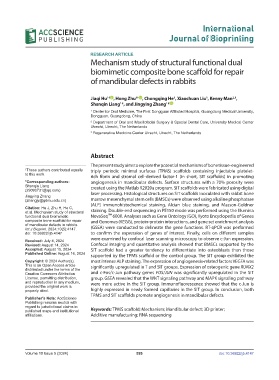Page 534 - IJB-10-5
P. 534
International
Journal of Bioprinting
RESEARCH ARTICLE
Mechanism study of structural functional dual
biomimetic composite bone scaffold for repair
of mandibular defects in rabbits
Jiaqi Hu 1† id , Hong Zhu 1† id , Chongqing He , Xiaochuan Liu , Kenny Man ,
2,3
1
1
Shanqin Liang *, and Jingying Zhang *
1
1 id
1 Center for Oral Medicine, The First Dongguan Affiliated Hospital, Guangdong Medical University,
Dongguan, Guangdong, China
2 Department of Oral and Maxillofacial Surgery & Special Dental Care, University Medical Center
Utrecht, Utrecht, The Netherlands
3
Regenerative Medicine Center Utrecht, Utrecht, The Netherlands
Abstract
The present study aims to explore the potential mechanisms of bone tissue-engineered
† These authors contributed equally triply periodic minimal surfaces (TPMS) scaffolds containing injectable platelet-
to this work.
rich fibrin and stromal cell-derived factor-1 (in short, SIT scaffolds) in promoting
*Corresponding authors: angiogenesis in mandibular defects. Surface structures with a 70% porosity were
Shanqin Liang created using the Matlab R2020a program. SIT scaffolds were fabricated using digital
(29090731@qq.com)
Jingying Zhang laser processing. Histological structures on SIT scaffolds inoculated with rabbit bone
(zhangjy@gdmu.edu.cn) marrow mesenchymal stem cells (BMSCs) were observed using alkaline phosphatase
(ALP) immunohistochemical staining, Alcian blue staining, and Masson-Goldner
Citation: Hu J, Zhu H, He C,
et al. Mechanism study of structural staining. Double-end sequencing in PE150 mode was performed using the Illumina
functional dual biomimetic NovaSeq™ 6000. Analyses such as Gene Ontology (GO), Kyoto Encyclopedia of Genes
composite bone scaffold for repair and Genomes (KEGG), protein-protein interactions, and gene set enrichment analysis
of mandibular defects in rabbits.
Int J Bioprint. 2024;10(5):4147. (GSEA) were conducted to delineate the gene functions. RT-qPCR was performed
doi: 10.36922/ijb.4147 to confirm the expression of genes of interest. Finally, cells on different samples
were examined by confocal laser scanning microscopy to observe c-Jun expression.
Received: July 4, 2024
Revised: August 14, 2024 Confocal imaging and quantitative analysis showed that BMSCs supported by the
Accepted: August 15, 2024 SIT scaffold had a greater tendency to differentiate into osteoblasts than those
Published Online: August 16, 2024 supported by the TPMS scaffold or the control group. The SIT group exhibited the
Copyright: © 2024 Author(s). most intense ALP staining. The expression of angiogenesis-related factors VEGFA was
This is an Open Access article significantly upregulated in T and SIT groups. Expression of osteogenic gene RUNX2
distributed under the terms of the
Creative Commons Attribution and c-Fos/c-Jun pathway genes FOS/JUN was significantly upregulated in the SIT
License, permitting distribution, group. GSEA revealed that the WNT signaling pathway and MAPK signaling pathway
and reproduction in any medium, were more active in the SIT group. Immunofluorescence showed that the c-Jun is
provided the original work is
properly cited. highly expressed in newly formed capillaries in the SIT group. In conclusion, both
TPMS and SIT scaffolds promote angiogenesis in mandibular defects.
Publisher’s Note: AccScience
Publishing remains neutral with
regard to jurisdictional claims in
published maps and institutional Keywords: TPMS scaffold; Mechanism; Mandibular defect; 3D printer;
affiliations. Additive manufacturing; RNA sequencing
Volume 10 Issue 5 (2024) 526 doi: 10.36922/ijb.4147

